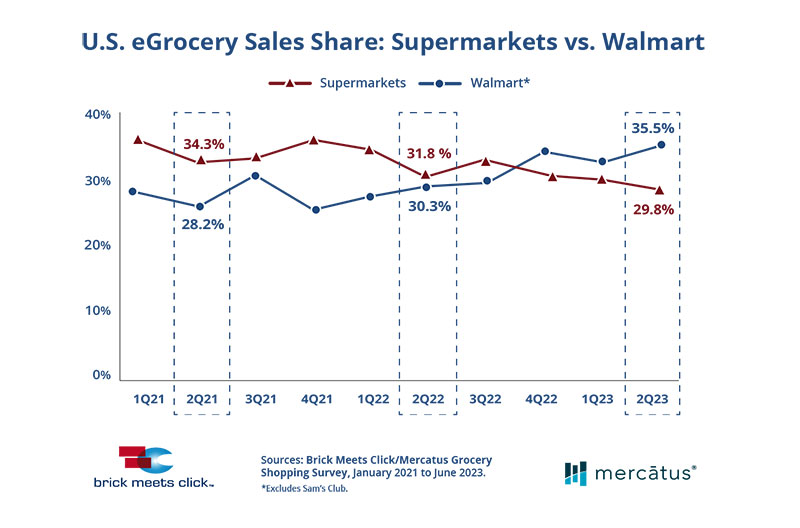Walmart captured nearly 36 percent of all U.S. eGrocery sales in the second quarter of 2023, up more than 5 percentage points from the prior year and its highest share to date, according to the new report, “Measuring the Online Grocery Market: eGrocery Share in the U.S.,” created by Brick Meets Click and sponsored by Mercatus.
In addition, the benefits that pickup offers helped to drive its share increase, which finished at 48 percent for the second quarter, almost two points higher than last year.
In the third quarter of 2022, Walmart’s share (excluding Sam’s Club) first surpassed supermarkets when food-at-home price inflation peaked, and it has been gradually fortifying its top spot as eGrocery market leader each quarter since then. While supermarkets held a 150-basis point share edge over Walmart last year during the second quarter, Walmart finished with a 570-bps share advantage this year.
“The combined effect of price inflation and the expiration of COVID financial supports has triggered a flight-to-value as purchasing power remains under pressure,” said David Bishop, partner at Brick Meets Click.
“This means it’s vital for grocers to offer customers more ways to save money while also providing the experience that online shoppers expect, as cost considerations will weigh more heavily than convenience for cash-strapped households in the second half of this year.”
Related to this research, an independent analysis of CPI data from the Bureau of Labor Statistics, also conducted by Brick Meets Click, documented that the purchasing power of U.S. households dropped more than 7 percent during the first half of 2023 versus a year ago. This was after it declined more than 9 percent in the first half of 2022 versus the same period in 2021. In comparison, purchasing power just prior to the pandemic was far less volatile, slipping just 0.5 percent and 1 percent during the first half of 2018 and 2019, respectively.
When it comes to how consumers are receiving their online grocery orders, pickup, the lower cost-to-use service compared to delivery, has steadily expanded its share of eGrocery sales over the last several years. In 2022, pickup gained 80 bps during the second quarter versus the prior year, and in 2023, it captured another 190 bps, ending the second quarter with a nearly 48 percent share of the U.S. market. Supermarkets, in addition to mass, contributed to the share growth as grocers continued to introduce pickup services at more store locations.
Target, another mass rival, is still holding its own in online grocery sales with moderate growth over the last two years. It has gained 70 bps of share versus 2021, and finished the second quarter of 2023 with approximately 7 percent of eGrocery sales. Strong and consistent execution – especially in fulfilling pickup orders – and a price gap that is halfway between supermarkets and Walmart likely offered a degree of defense for its online grocery business.
Total eGrocery sales were down 1.1 percent in the second quarter versus the prior year, and the main driver of the sales decline was fewer orders completed per household, down 5 percent year-over-year for the quarter. In addition, consumer interest in buying groceries online declined slightly except for the most engaged households. The share of U.S. households that completed one or more online orders during the second quarter contracted by 275 bps compared to a year ago to just under 53 percent.
The overall pullback was due to contractions across the three lower quartiles of online spending; meanwhile, the households who report doing at least 75 percent of their grocery spending online expanded by 292 bps versus the second quarter of 2022.
“As competition for the shopper intensifies, regional grocers should be leveraging analytics and insights to provide customers with personalized recommendations, discounts and offers as well as developing targeted, cost-effective strategies to encourage and reward repeat purchases online and in-store,” said Sylvain Perrier, president and CEO, Mercatus.
“In addition, grocers can expand the online market they serve by offering pickup as a lower-cost alternative to delivery.”
While repeat intent rates during the second quarter were down slightly versus last year across pickup and delivery and for core formats (mass, supermarkets and hard discount), the gap between mass and supermarkets for both receiving methods continued to widen. The gap in repeat intent that mass had over supermarkets for delivery climbed by 210 bps and pickup’s grew by 560 bps.
About this report and analysis
“Measuring the Online Grocery Market: eGrocery Share in the U.S.” is designed to help grocery retailers and their suppliers understand the how the eGrocery market is shifting by providing market share estimates across several retail formats (supermarkets, mass, hard discount, etc.) and receiving methods (delivery, pickup and ship-to-home) over a two-and-a-half-year period, running between January 2021-June 2023.
The analysis leverages data from the monthly Brick Meets Click/Mercatus Grocery Shopping Survey, an independent research initiative created and conducted by Brick Meets Click since March 2020, and sponsored by Mercatus. This analysis is based on 21,799 responses compiled over the 12 months of 2021, 20,948 responses compiled over the 12 months of 2022, and 11,001 responses over the first six months of 2023 from adults 18 years and older who participated in the household’s grocery shopping.
Read more technology news from The Shelby Report.

